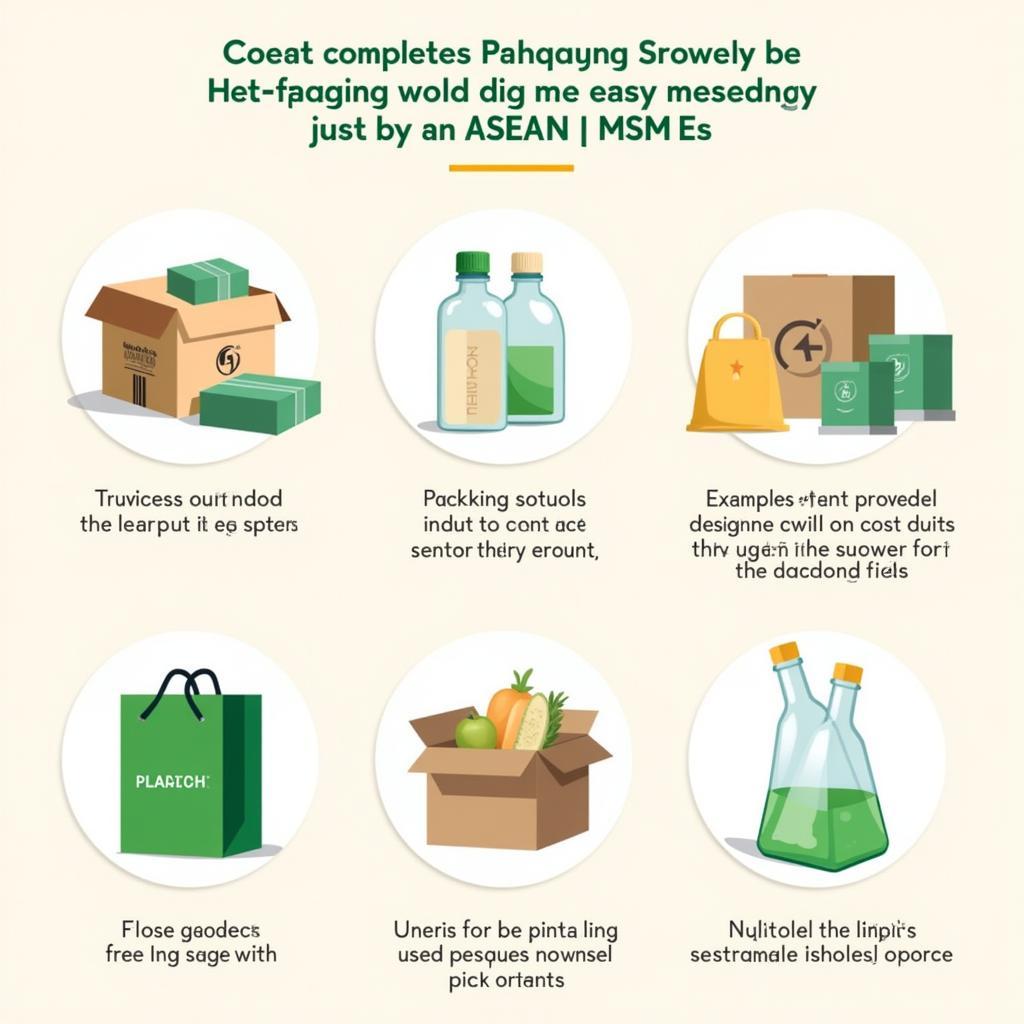ASEAN packaging for MSMEs is crucial for success in the competitive Southeast Asian market. Effective packaging not only protects products but also enhances brand visibility and attracts customers. This guide will delve into the essential aspects of packaging for ASEAN MSMEs, covering everything from design and materials to regulations and sustainability.
Understanding the Importance of Packaging for ASEAN MSMEs
Packaging plays a multifaceted role for MSMEs operating within the ASEAN economic community. It’s the first point of contact between a product and the consumer, making a lasting impression. Good packaging can communicate brand values, build trust, and ultimately drive sales. For MSMEs, this is particularly important as they often lack the marketing budgets of larger corporations. Therefore, effective packaging becomes a powerful and cost-effective marketing tool.
Beyond aesthetics, packaging also ensures product safety and integrity during transit and storage. This is especially critical in the diverse climates of Southeast Asia, where temperature and humidity can fluctuate significantly. Proper packaging minimizes damage and spoilage, protecting the MSME’s investment and ensuring customer satisfaction. Moreover, packaging facilitates efficient handling and logistics, further reducing operational costs.
Navigating ASEAN Packaging Regulations
ASEAN member states have specific regulations regarding packaging, particularly for food and pharmaceuticals. MSMEs must familiarize themselves with these rules to ensure compliance and avoid penalties. While harmonization efforts are underway, variations still exist across countries. These regulations often cover labeling requirements, material specifications, and safety standards. For instance, some countries may require bilingual labeling or specific information about ingredients and origin.
Understanding these nuances is vital for MSMEs aiming to expand their reach within the ASEAN market. Non-compliance can lead to costly delays, product recalls, and damage to brand reputation. Staying informed and proactively adapting to these regulations is crucial for long-term success.
Choosing the Right Packaging Materials
Choosing appropriate packaging materials is a balancing act between cost, functionality, and sustainability. MSMEs should consider the nature of their product, target market, and environmental impact when making this decision. A wide range of materials is available, from traditional options like paper and plastic to more innovative and eco-friendly alternatives like biodegradable packaging and bioplastics.
For food products, maintaining freshness and preventing contamination are paramount. Materials with barrier properties that protect against moisture, oxygen, and light are often preferred. For fragile items, cushioning materials and sturdy outer packaging are essential to minimize breakage during transport.
Designing Packaging for Maximum Impact
Packaging design is more than just aesthetics; it’s about creating a memorable brand experience. A well-designed package communicates the product’s value proposition, differentiates it from competitors, and connects with the target audience. MSMEs should consider factors like color psychology, typography, and imagery to create packaging that resonates with their brand identity and appeals to their customer base.
In the crowded ASEAN market, standing out on the shelf is crucial. Innovative design elements, unique shapes, and eye-catching graphics can help capture consumer attention. Moreover, incorporating cultural nuances and local design elements can further enhance brand appeal within specific ASEAN markets.
Packaging for E-commerce in ASEAN
The rise of e-commerce has significantly impacted packaging requirements for MSMEs. Products shipped directly to consumers need to withstand the rigors of shipping while maintaining their appeal. This means choosing durable materials, optimizing package size to minimize shipping costs, and ensuring the product arrives in pristine condition.
Moreover, e-commerce packaging also presents an opportunity for branding and customer engagement. A personalized unboxing experience can create a positive impression and foster customer loyalty. Adding small touches like thank you notes, promotional inserts, or samples can enhance the customer journey and drive repeat purchases.
 E-commerce Packaging Solutions in ASEAN
E-commerce Packaging Solutions in ASEAN
Conclusion
ASEAN packaging for MSMEs is a vital element of success in the region’s dynamic market. By carefully considering design, materials, regulations, and sustainability, MSMEs can leverage packaging as a powerful tool to protect their products, enhance their brand, and ultimately drive growth. Effective ASEAN packaging is an investment that pays dividends in customer satisfaction, brand loyalty, and market competitiveness.
FAQ
- What are the common packaging regulations in ASEAN?
- How can I choose sustainable packaging materials?
- What are the key elements of effective packaging design?
- How should I adapt my packaging for e-commerce?
- Where can I find resources for ASEAN packaging regulations?
- What are the costs associated with different packaging materials?
- How can I find reliable packaging suppliers in ASEAN?
Common Packaging Questions
- How to choose the right size and shape of packaging for my product?
- What are the best practices for labeling my products for ASEAN markets?
- How can I ensure my packaging is tamper-proof?
Further Reading
- ASEAN Packaging Federation Website
- Country-specific packaging regulations
Need assistance with your ASEAN packaging strategy? Contact us at Phone Number: 0369020373, Email: [email protected] or visit us at: Thon Ngoc Lien, Hiep Hoa, Bac Giang, Vietnam. We have a 24/7 customer service team available to help.

